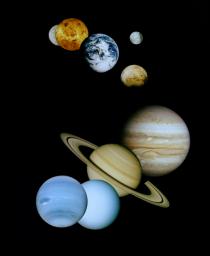| Lecture |
Links |
PDF version | Animations |
Lecture recording |
|---|
1. Introduction to the Solar System; The Earth as a planet
We set the scene, showing where we are in the universe, and
discuss the Earth as a planet. |
Lecture 1
links |
VP1-Intro+Earth.pdf (20 Mb) |
 Earth topography (8.2
Mb) Earth topography (8.2
Mb)
Original from http://sos.noaa.gov/datasets/Land/etopo2.html
 Weather in 2013 (18 Mb) Weather in 2013 (18 Mb)
Original from https://www.theguardian.com/uk-news/video/2014/jan/29/2013-weather-systems-60-seconds-video
 Earth's rotation from Galileo (2 Mb) Earth's rotation from Galileo (2 Mb)
Original from http://svs.gsfc.nasa.gov/stories/nasm/movies.html
|
Lecture
1 |
2. The Moon, our nearest neighbour; Spaceflight
We look at the Moon as the only other solar system body humans have
set foot on. Then we discuss the basics of space flight, looking at
how we get to other planets. |
Lecture 2
links |
VP2-Moon+Spaceflight.pdf (17 Mb) |
 Libration of the moon (484 kb) Libration of the moon (484 kb)
Original from http://www.astrosurf.com/cidadao/animations.htm
 Lunar impact blast (15.4 Mb) Lunar impact blast (15.4 Mb)
Original from https://www.youtube.com/watch?v=perqv4qByaI
 Lunar rotation (4.8 Mb) Lunar rotation (4.8 Mb)
Original from http://apod.nasa.gov/apod/ap130916.html
 Moon-forming impact (2.8 Mb) Moon-forming impact (2.8 Mb)
Original from http://www.swri.edu/press/impact.htm
 Lagrange-point impactor (308 kb) Lagrange-point impactor (308 kb)
Original from http://en.wikipedia.org/wiki/Giant_impact_theory
 Evolution of the Moon (11 Mb) Evolution of the Moon (11 Mb)
Original from http://apod.nasa.gov/apod/ap120320.html
Orbit animations all together on one page.
 Aerobraking (5.2 Mb) Aerobraking (5.2 Mb)
Original from http://mars.jpl.nasa.gov/odyssey/gallery/video/2001-2004.html
|
Lecture 2 |
3. The inner planets: Mercury and Venus
|
Lecture 3
links |
VP3-Mercury+Venus.pdf (13 Mb) |
 Mercury rotation (1.3 Mb) Mercury rotation (1.3 Mb)
 Mercury flyover (14.7 Mb) Mercury flyover (14.7 Mb)
Original from http://messenger.jhuapl.edu/the_mission/movies.html
 Mercury globe rotation (14.7 Mb) Mercury globe rotation (14.7 Mb)
Original from http://messenger.jhuapl.edu/the_mission/movies.html
 Venus rotation (1.7 Mb) Venus rotation (1.7 Mb)
 South polar vortex (314 kb) South polar vortex (314 kb)
Original from http://sci.esa.int/science-e/www/object/index.cfm?fobjectid=39671 |
Lecture 3 |
4. Mars, the Red Planet
We look at what we've learned about Mars, and discuss the prospects
and problems of possible manned missions to Mars. |
Lecture 4
links |
VP4-Mars.pdf (27 Mb) |
 Curiosity view of Phobos and Deimos (3.2 Mb) Curiosity view of Phobos and Deimos (3.2 Mb)
Original from http://photojournal.jpl.nasa.gov/catalog/PIA17089
 Dust devils (6 Mb) Dust devils (6 Mb)
Original from http://photojournal.jpl.nasa.gov/catalog/PIA09260
 Mars impact animation (805 kb) Mars impact animation (805 kb)
Original from http://www.newscientist.com/article/dn11387
|
Lecture 4 |
5. Rocks in space: asteroids, comets and meteorites
We look at the various smaller bodies in the Solar System, and discuss
their effects on the planets. |
Lecture 5
links |
VP5-Rocks.pdf (23 Mb) |
Eros rotation:  movie 1 (1.1 Mb), movie 1 (1.1 Mb),
 movie 2 (3.9 Mb), movie 2 (3.9 Mb),
 movie 3 (1.3 Mb) movie 3 (1.3 Mb)
Originals from http://nssdc.gsfc.nasa.gov/planetary/mission/near/near_eros_anim.html
 Mathilde encounter (500 kb) Mathilde encounter (500 kb)
Original from http://near.jhuapl.edu/Images/Anim.html
 Vesta full rotation (3.3 Mb) Vesta full rotation (3.3 Mb)
Original from http://dawn.jpl.nasa.gov/multimedia/vesta_full_rotationMovie.asp
 Rosetta comet rotation (2.1 Mb) Rosetta comet rotation (2.1 Mb)
Original from http://www.planetary.org/blogs/emily-lakdawalla/2014/09151433-a-landing-site-for-philae.html
 Chelyabinsk video compilation (25 Mb) Chelyabinsk video compilation (25 Mb)
Original from https://www.youtube.com/watch?v=SMnZr5DDRlA
 B612 impact video (8.5 Mb) B612 impact video (8.5 Mb)
Original from http://www.wired.co.uk/news/archive/2014-04/22/asteroid-impacts |
Lecture
5 |
6. Jupiter
We look at Jupiter and its satellite systems, revealed in all their
glory by the Voyager missions and Galileo. |
Lecture 6 links |
VP6-Jupiter.pdf (31 Mb) |
 Jupiter rotation movie (3.4 Mb) Jupiter rotation movie (3.4 Mb)
Original from http://photojournal.jpl.nasa.gov/catalog/PIA02863
 Europa Tide Movie (4.1 Mb) Europa Tide Movie (4.1 Mb)
Original from http://photojournal.jpl.nasa.gov/catalog/PIA10149
 Cycloid formation (140 kb) Cycloid formation (140 kb)
Original from http://pirlwww.lpl.arizona.edu/~hoppa/science.html
 Io rotation (125 kb) Io rotation (125 kb)
Original from http://csep10.phys.utk.edu/astr161/lect/jovian_moons/io.html |
Lecture
6 |
7. Saturn
We look at the latest results from Cassini-Huygens and what they tell
us about the ringed planet. |
Lecture 7 links |
VP7-Saturn.pdf (42 Mb) |
 Cassini orbit (10.7 Mb) Cassini orbit (10.7 Mb)
Original from http://saturn.jpl.nasa.gov/multimedia/videos/video-details.cfm?videoID=85
 Saturn rotation (5.7 Mb) Saturn rotation (5.7 Mb)
Original from http://hubblesite.org/newscenter/archive/releases/solar-system/2007/13/
 Cassini ring-plane crossing (38.4 Mb) Cassini ring-plane crossing (38.4 Mb)
Original from http://photojournal.jpl.nasa.gov/catalog/PIA08356
 Huygens landing (6.3 Mb) Huygens landing (6.3 Mb)
Original from http://saturn.jpl.nasa.gov/multimedia/videos/video-details.cfm?videoID=79
 Hyperion fly-by (67.8 Mb) Hyperion fly-by (67.8 Mb)
Original from http://photojournal.jpl.nasa.gov/catalog/PIA07742
 Saturn moon ballet (6.7 Mb) Saturn moon ballet (6.7 Mb)
Original from http://saturn.jpl.nasa.gov/video/videodetails/?videoID=206
 Titan Land of Lakes (30 Mb) Titan Land of Lakes (30 Mb)
Original from http://saturn.jpl.nasa.gov/video/videodetails/?videoID=271
 Cassini: Coming attractions at Saturn (110 Mb) Cassini: Coming attractions at Saturn (110 Mb)
Original from http://saturn.jpl.nasa.gov/video/videodetails/?videoID=274 |
Much to my surprise, the lecture recording worked last
night, but cut off early, so the end is missing
Lecture
7 |
8. The outer solar system: Uranus, Neptune and (minor) planets beyond
|
Lecture 8 links |
VP8-Outer-planets.pdf (44 Mb) |
 Rotating Uranus (18 Mb) Rotating Uranus (18 Mb)
Original from http://hubblesite.org/newscenter/archive/1999/11/
 Uranus magnetic field (5.2 Mb) Uranus magnetic field (5.2 Mb)
Original from http://csep10.phys.utk.edu/astr161/lect/uranus/surface.html
 Rotating Neptune (484 kb) Rotating Neptune (484 kb)
Original from http://hubblesite.org/newscenter/archive/1996/33/
 Rotating Pluto (616 kb) Rotating Pluto (616 kb)
Original from http://hubblesite.org/newscenter/archive/1996/09/
 Long range view of Pluto and Charon (43 kb) Long range view of Pluto and Charon (43 kb)
Original from http://pluto.jhuapl.edu/gallery/sciencePhotos/image.php?gallery_id=2&image_id=101
 Orbits of Pluto and PT1 (6.3 Mb) Orbits of Pluto and PT1 (6.3 Mb)
Original from http://www.planetary.org/blogs/emily-lakdawalla/2014/10151024-finally-new-horizons-has-a-kbo.html |
Lecture 8 |
9. Formation of the solar system
We look at how the solar system formed from the original cloud of
interstellar gas and dust. |
Lecture 9 links |
VP9-Formation.pdf (44 Mb) |
 Moon-forming impact (2.8 Mb) Moon-forming impact (2.8 Mb)
Original from http://www.swri.edu/press/impact.htm
 Scattering of Uranus and Neptune (90.4 Mb) Scattering of Uranus and Neptune (90.4 Mb)
Original from http://www.boulder.swri.edu/~hal/talks.html
WARNING! this file is HUGE. |
Lecture 9 |
10. Extrasolar planets
We discuss the large number of planets now being discovered in other
star systems, and discuss how these discoveries affect what we know
about our own Solar System. |
Lecture 10 links |
VP10-Exoplanets.pdf (21 Mb) |
|
Lecture 10 |



